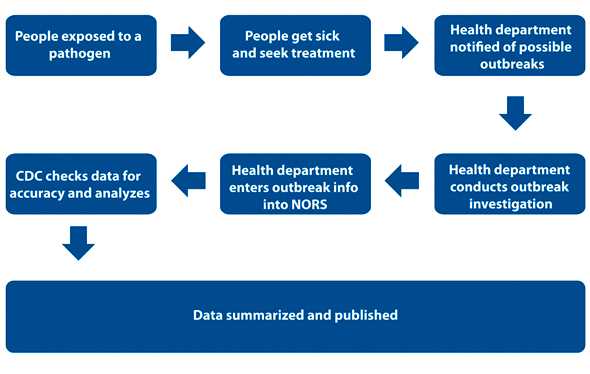About NORS
What are enteric illnesses?
Enteric illnesses are characterized by symptoms such as diarrhea, nausea, or vomiting. Some microbes such as E. coli cause enteric illness and may also cause other types of symptoms or conditions, such as hemolytic uremic syndrome, or HUS.
The National Outbreak Reporting System (NORS) supports outbreak reporting by partners in state, local, and territorial public health agencies.
The Centers for Disease Control and Prevention (CDC) launched NORS in 2009 as a web-based platform into which health departments enter outbreak information. Through NORS, CDC collects reports of enteric disease outbreaks caused by bacterial, viral, parasitic, chemical, toxin, and unknown agents, as well as waterborne outbreaks of non-enteric disease.
If you are a member of the general public and would like to report an outbreak, please contact your local or state health department. Contact information can be found at Public Health Resources: State Health Departments.
Improved reporting of outbreaks
National foodborne and waterborne disease outbreak surveillance has been a core function of CDC since the 1970s. Two surveillance systems handle this responsibility: the Waterborne Disease and Outbreak Surveillance System (1971-present) and the Foodborne Disease Outbreak Surveillance System (1973-present). Foodborne disease outbreak data have been collected electronically since 1998. NORS was designed to integrate the outbreak reporting systems and enhance national outbreak reporting with new components.
NORS collects data on these types of outbreaks in the United States:
- Waterborne disease outbreaks – all outbreaks of respiratory, skin, enteric or other types of illness spread primarily through water, including water that people drink, swim in, or use for other purposes
- Foodborne disease outbreaks – all outbreaks of enteric illness spread through food
- Person-to-person transmitted disease outbreaks – all outbreaks of enteric illness spread directly from one person to another through direct contact, such as by handshake or kissing
- Animal contact disease outbreaks – all outbreaks of enteric illness spread to humans from contact with animals, such as a pet turtle or frog, or their environments
- Environmental contamination outbreaks – all outbreaks of enteric illness spread through contact with other environmental sources, such as dirty linens or surfaces that people touch in bathrooms.
- Other enteric illness outbreaks – all outbreaks of enteric illness spread through other or unknown means
NORS is a valuable tool for collecting outbreak data needed to improve public health
Outbreak investigations are most often initiated by state, local, and territorial public health agencies and by CDC. Outbreaks are reported to CDC using NORS, which collects information such as date and location of the outbreak, the number of people who became ill and their symptoms, and the pathogen that caused the outbreak. The data from outbreak investigations are checked for accuracy and analyzed by CDC to provide information about national outbreak trends and learning lessons for preventing future outbreaks.

The flow of outbreak information to NORS. 1) People are exposed to a pathogen; 2) People get sick and seek treatment; 3) Health department is notified of a possible outbreak; 4) Health department conducts an outbreak investigation; 5) Health department enters outbreak information into NORS; 6) CDC checks data for accuracy and analyzes; 7) Data are summarized and published.
Other organizations that collaborate with CDC on outbreak surveillance and prevention include the Council of State and Territorial Epidemiologists (CSTE), the United States Environmental Protection Agency (EPA), the United States Food and Drug Administration (FDA), and the United States Department of Agriculture (USDA).
NORS improves on over 40 years of outbreak surveillance at CDC, helping to integrate and streamline surveillance systems, enhance state and local health department outbreak reporting, and provide needed information to CDC, health departments, and policy makers for prevention of future outbreaks.
- Page last reviewed: August 23, 2016
- Page last updated: September 3, 2015
- Content source:


 ShareCompartir
ShareCompartir